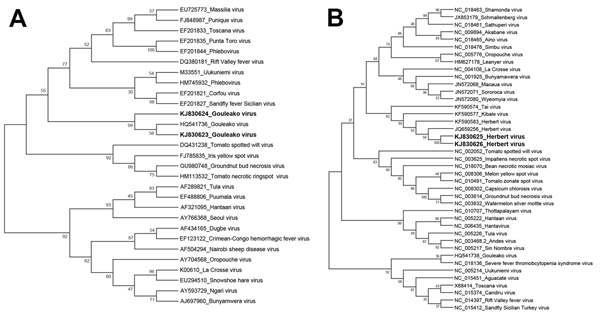Volume 20, Number 12—December 2014
Dispatch
Gouleako and Herbert Viruses in Pigs, Republic of Korea, 2013
Figure 2

Figure 2. Phylogenetic analyses of Gouleako virus (GOLV) and Herbert virus (HEBV) collected from swine in the Republic of Korea, 2013 (KJ830623–J830626, in boldface), and other family Bunyaviridae viruses. The bootstrap consensus trees were constructed by using the maximum-likelihood method based on the general time-reversible model, implemented in MEGA version 6.06 (http://www.megasoftware.net). The phylogenetic trees for GOLV (A) and HEBV (B) were inferred on the basis of nucleotide sequences of the gene encoding nucleocapsid protein (GOLV) or RNA-dependent RNA polymerase (HEBV). The bootstrap values are shown next to the branches. Bunyaviridae virus sequences from previous studies (9,10) were used as reference sequences.
References
- Wu Y, Gao GF. Severe fever with thrombocytopenia syndrome virus expands its borders. Emerging Microbes & Infections. 2013;2:e36.
- Chang MS, Woo JH. Severe fever with thrombocytopenia syndrome: tick-mediated viral disease. J Korean Med Sci. 2013;28:795–6. DOIPubMedGoogle Scholar
- Lambert AJ, Blair CD, D'Anton M, Ewing W, Harborth M, Seiferth R, La Crosse virus in Aedes albopictus mosquitoes, Texas, USA, 2009. Emerg Infect Dis. 2010;16:856–8. DOIPubMedGoogle Scholar
- Coetzer JA. The pathology of Rift Valley fever. II. Lesions occurring in field cases in adult cattle, calves and aborted foetuses. Onderstepoort J Vet Res. 1982;49:11–7 .PubMedGoogle Scholar
- Zhioua E, Moureau G, Chelbi I, Ninove L, Bichaud L, Derbali M, Punique virus, a novel phlebovirus, related to sandfly fever Naples virus, isolated from sandflies collected in Tunisia. J Gen Virol. 2010;91:1275–83. DOIPubMedGoogle Scholar
- Hoffmann B, Scheuch M, Höper D, Jungblut R, Holsteg M, Schirrmeier H, Novel orthobunyavirus in cattle, Europe, 2011. Emerg Infect Dis. 2012;18:469–72. DOIPubMedGoogle Scholar
- Kim KH, Yi J, Kim G, Choi SJ, Jun KI, Kim NH, Severe fever with thrombocytopenia syndrome, South Korea, 2012. Emerg Infect Dis. 2013;19:1892–4. DOIPubMedGoogle Scholar
- Bilk S, Schulze C, Fischer M, Beer M, Hlinak A, Hoffmann B. Organ distribution of Schmallenberg virus RNA in malformed newborns. Vet Microbiol. 2012;159:236–8. DOIPubMedGoogle Scholar
- Marklewitz M, Handrick S, Grasse W, Kurth A, Lukashev A, Drosten C, Gouleako virus isolated from West African mosquitoes constitutes a proposed novel genus in the family Bunyaviridae. J Virol. 2011;85:9227–34. DOIPubMedGoogle Scholar
- Marklewitz M, Zirkel F, Rwego IB, Heidemann H, Trippner P, Kurth A, Discovery of a unique novel clade of mosquito-associated bunyaviruses. J Virol. 2013;87:12850–65 . DOIPubMedGoogle Scholar
Page created: November 19, 2014
Page updated: November 19, 2014
Page reviewed: November 19, 2014
The conclusions, findings, and opinions expressed by authors contributing to this journal do not necessarily reflect the official position of the U.S. Department of Health and Human Services, the Public Health Service, the Centers for Disease Control and Prevention, or the authors' affiliated institutions. Use of trade names is for identification only and does not imply endorsement by any of the groups named above.